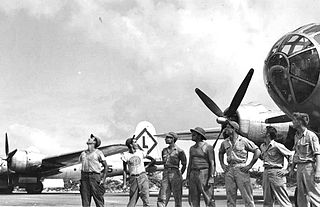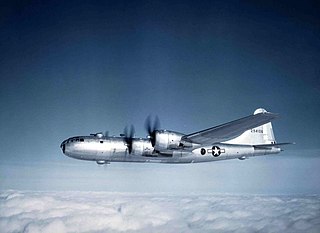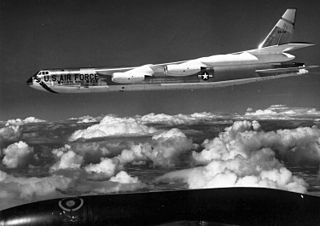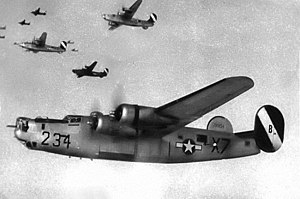
Royal Air Force Rackheath, more commonly known as RAF Rackheath, is a former Royal Air Force station located near the village of Rackheath, approximately 6 miles north-east of Norwich, in the county of Norfolk in England.

Fairmont State Airfield is three miles south of Fairmont, in Fillmore County, Nebraska. The National Plan of Integrated Airport Systems for 2011–2015 categorized it as a general aviation facility. It has no scheduled airline service.

The 458th Air Expeditionary Group is a provisional United States Air Force unit assigned to United States Air Forces in Europe to activate or inactivate as needed. The most recent known activation of the unit was at Ramstein Air Base, Germany in 2011.

The 331st Bombardment Group is an inactive United States Air Force unit. It was last assigned to the 315th Bombardment Wing, being stationed at Northwest Field, Guam. It was inactivated on 15 April 1946.

The 467th Bombardment Group is an inactive United States Army Air Forces unit. Its last assignment was to the Strategic Air Command, being stationed at Clovis Army Airfield, New Mexico. It was inactivated on 4 August 1946.

The 382d Bombardment Group is a former United States Army Air Forces unit. It was last stationed at Camp Anza, California, where it was inactivated on 4 January 1946. The group was active from 1942 to 1944 as a heavy bomber training unit. It was reorganized as a very heavy bomber unit and trained for deployment overseas. However, it arrived at its overseas station too late to see combat, and returned to the United States, where it was inactivated.

The United States Air Force's 9th Combat Operations Squadron is an Air Force Reserve Command space operations unit located at Vandenberg Space Force Base, California. The 9th augments the 614th Air and Space Operations Center in operating the Joint Space Operations Center, performing combat operations, plans, strategy and intelligence assessments that enable the Commander, Joint Functional Component Command for Space to command and control space forces by providing worldwide space effects and theater support to combatant commanders.

The 864th Bombardment Squadron is an inactive United States Air Force unit. Its last assignment was with the 494th Bombardment Wing at Sheppard Air Force Base, Texas, where it flew Boeing B-52 Stratofortresses under Strategic Air Command. It was inactivated on 2 April 1966.

The 448th Supply Chain Management Group is an inactive United States Air Force unit. Its last assignment was to the 448th Supply Chain Management Wing at Tinker Air Force Base, Texas, where it was inactivated on 30 June 2010.

The United States Air Force's 10th Intelligence Support Squadron is an intelligence unit located at Langley Air Force Base, Virginia.

The 828th Bombardment Squadron was a squadron of the United States Army Air Forces. It was active during World War II in the Mediterranean Theater of Operations as a Consolidated B-24 Liberator unit, where it earned a Distinguished Unit Citation. Following V-E Day, the squadron returned to the United States and began training with the Boeing B-29 Superfortress at Smoky Hill Army Air Field, Kansas, before inactivating in August 1946 ans transferring its personnel to another unit that was activated in its place.

The 754th Bombardment Squadron is a former United States Army Air Forces unit. The squadron was first activated in July 1943. After training with Consolidated B-24 Liberator heavy bombers in the United States, it deployed to the European Theater of Operations, where it participated in the strategic bombing campaign against Germany. Following V-E Day, the squadron returned to the United States, where it began training with Boeing B-29 Superfortresses, but was inactivated in October 1945.

The 362d Tactical Electronic Warfare Squadron is an inactive United States Air Force unit. It was last assigned to the 6498th Air Base Wing at Da Nang Air Base, Republic of Vietnam. It was inactivated on 28 February 1973.

The 784th Bombardment Squadron is the senior predecessor of the 784th Tactical Air Support Training Squadron. It was organized in August 1943 as a heavy bomber unit. After training in the United States with Consolidated B-24 Liberators, the 784th moved to England, where it participated in the strategic bombing campaign against Germany. Following V-E Day, it returned to the United States, where it began training with Boeing B-29 Superfortresses, but was inactivated in October 1945.

The 786th Air Expeditionary Squadron is a provisional unit of the United States Air Force, assigned to United States Air Forces in Europe (USAFE) to activate or inactivate as needed. USAFE has activated the squadron for short periods of contingency operations.

The 787th Air Expeditionary Squadron is a provisional United States Air Force unit, assigned to United States Air Forces Europe. The squadron has been activated twice for contingency operations in Africa.

The 872nd Bombardment Squadron is the former name of the 872nd Air Expeditionary Squadron, a provisional unit of the United States Air Force. It is assigned to United States Air Forces Europe to activate or inactivate as needed.

The 788th Tactical Fighter Squadron is an inactive United States Air Force unit. During World War II, as the 788th Bombardment Squadron, it was assigned to the 467th Bombardment Group as a Consolidated B-24 Liberator squadron in 1943. After training in the United States, it moved to the European Theater of Operations the following year. It saw combat until the surrender of Germany in May 1945, earning a French Croix de Guerre with Palm for its actions contributing to the liberation of France. From May to August 1944, the squadron was detached to the 801st Bombardment Group (Provisional) engaging in Operation Carpetbagger operations. After V-E Day, the squadron returned to the United States and transitioned into the Boeing B-29 Superfortress It was inactivated on 4 August 1946 at Clovis Army Air Field, New Mexico.

The 790th Bombardment Squadron is a former United States Army Air Forces unit, established as a Consolidated B-24 Liberator squadron in 1943. After training in the United States, it moved to the European Theater of Operations the following year. During World War II it was assigned to the 467th Bombardment Group, and engaged in the strategic bombing campaign against Germany. After V-E Day, the squadron returned to the United States and transitioned into the Boeing B-29 Superfortress. It was inactivated on 4 August 1946 at Clovis Army Air Field, New Mexico in March 1946 and its resources were transferred to another unit.

The 791st Bombardment Squadron is a former United States Army Air Forces unit. During World War II it was assigned to the 467th Bombardment Group, and engaged in the strategic bombing campaign against Germany. After V-E Day, the squadron returned to the United States and transitioned into the Boeing B-29 Superfortress. It was inactivated on 31 March 1946 at Roswell Army Air Field, New Mexico in March 1946 and its resources were transferred elsewhere.























